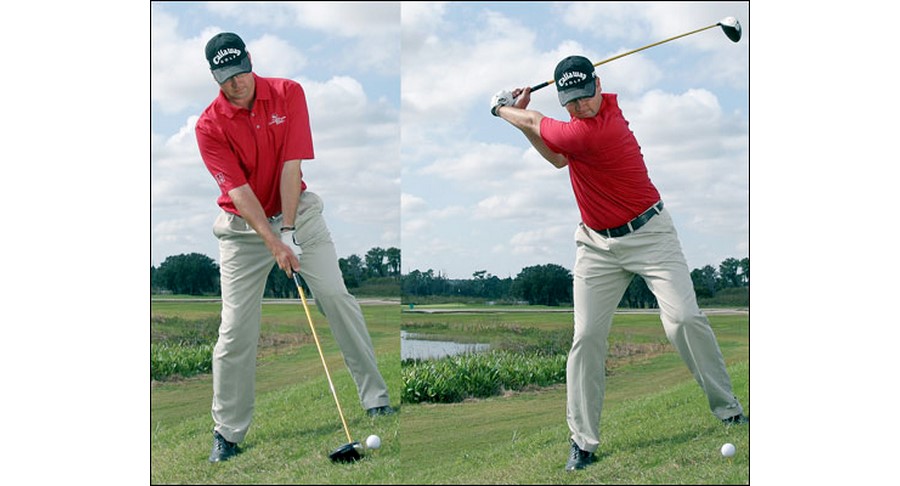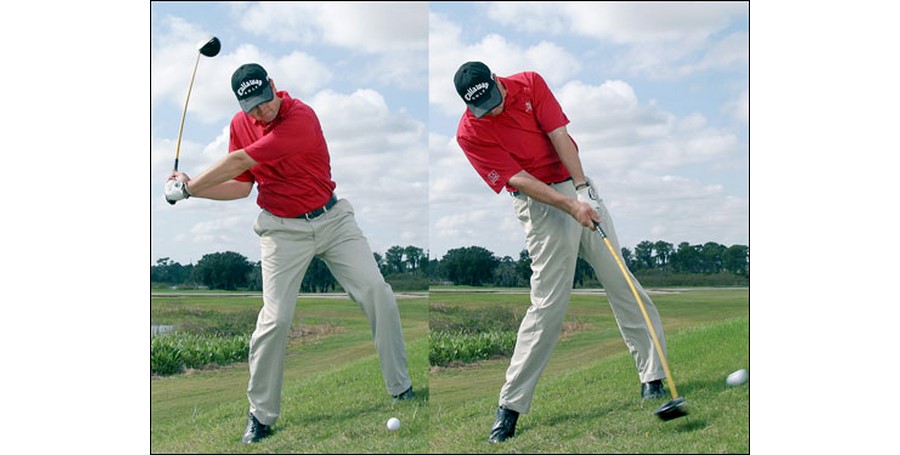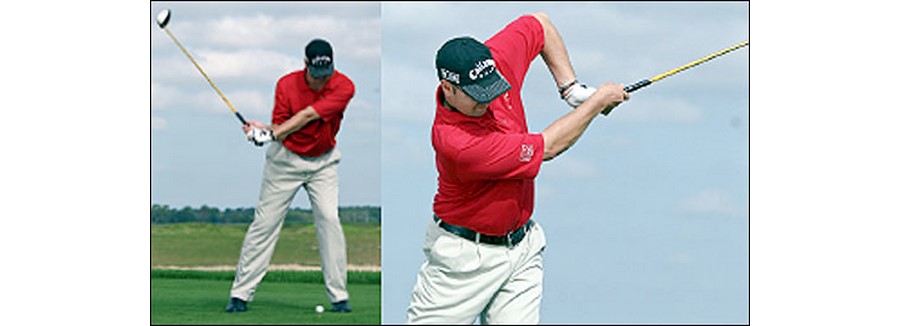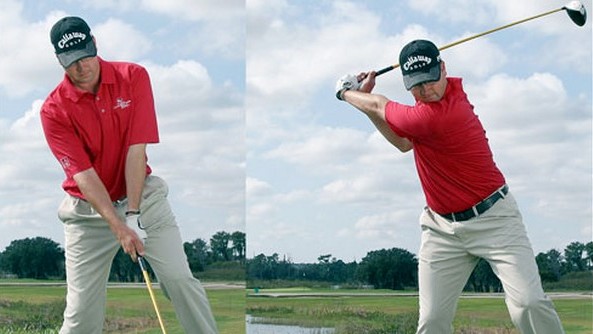When you stop and think logically about the dynamics involved in the golf swing, specifically when it comes to working on your technique off the tee, it makes sense that in order to strike the back of the ball solidly with a slightly ascending blow (being the ideal scenario with the driver) you first have to get fully behind the ball in the backswing. And yet, for the vast majority of amateur golfers, getting ‘ahead of the ball’ – i.e. being too narrow and too steep on the down swing – is the biggest problem and significant barrier to achieving their maximum distance off the tee.
So the crux of this article is that I want to impress upon you the importance of (a) getting correctly setup to the ball with the driver (i.e. with your spine tilted slightly away from the target and your weight favouring your right side, in a manner that positively assists you in making a good turn and getting ‘loaded up’ into the right side) and (b) to then make a point of staying behind the ball as you unwind and accelerate the clubhead through impact on the slightly upward arc that gives you the optimum trajectory for distance. To achieve this it’s vital that your head remains behind the ball as you rotate and release the arms through the shot – that’s a key lesson you have to learn to drive the ball solidly.
Before we look at the full swing in detail, let me show you a practice drill that will help you to experience the sensations we are looking for off the tee without even having to think too much about how they occur….
Power key – Get behind the ball ans stay behind the ball for a powerful sweep and full release through impact

The left knee moves across as the weight is transferred and ‘loaded’ into the right side, and the left knee then activates the change in direction from the top
A quick & effective swing fix
The next time you get the opportunity, spend a few minutes hitting shots from an uphill lie, as I am doing here. This is a terrific drill to experience the feeling of (a) getting yourself properly set-up,with your weight favouring your right side, before (b) enjoying a very real sense of being behind the ball at the top of the backswing.

Right knee and thigh provide the resistance as you turn and coil your upper body

Launch the shot up the slope, collecting the ball as you accelerate through impact.
Naturally, the slope exaggerates these feelings,but it will give you a very real and immediate sensation of what ‘staying behind the ball’ actually feels like in the swing. The effect of the slope will be such that it is virtually impossible not to get yourself fully behind the ball as you complete the back swing,and you want to focus on maintaining that feeling for as long as you can in the down swing to give yourself the best possible chance of releasing the club head solidly into the back of the ball. Whether you hit balls with this drill, or simply make a few practice swings, these feelings will quickly lessen any tendency you might have to get ahead of the shot with your upper body,and transform your ability to sweep the ball off the tee with the driver.
Before you can seriously expect to go out and improve both the consistency and the power of your swing with the driver, you first have to understand the nature of the strike that your are aiming to deliver to the back of the ball.
While the majority of the shots with the irons are played with a slight downward strike (hence the shallow divot taken after the ball is struck), the key with the driver is that you work on maximising clubhead speed with a swing that catches the ball ever so slightly on the upswing for the optimum (i.e. low) spin and ‘rainbow’ trajectory that gives you the maximum distance.
Modern drivers are designed to launch the ball relatively high, and in order to make the most of this is vital that you understand how to adjust your set-up so that you are able to turn and coil your upper body behind the ball in the backswing and then keep your head steady behind the ball as you unwind and release the club through impact. Lurching forward with the head/upper body denies you the opportunity to unwind in sequence and plant the maximum speed on the ball. This drill is the perfect antidote.
Turn & shift: load behind
The sequence here illustrates perfectly the way in which one good moves leads seamlessly to another – and it all starts at the set-up.With a driver, the longest of all the clubs in your bag, you want to stand as tall as possible before creating a gentle flex in the knees that enables you to stick your rear end out a little as you bend from the hips to establish your spine angle.

2) Hands remain passive as the rotation of the torso moves arms and club – terrific width here
3) Wrists hinge to swing the club up. Right thigh is the ‘brace’
4) Full turn gets the shoulders fully behind the ball

Wrists still fully hinged and loaded with power, eyes fixed on back of the ball. ‘Collect’ the ball as you free-wheel the clubhead through to a full finish
The arms hang comfortably and form a distinct triangle with the shoulders. Other details to note include ball position, moved up in the stance, opposite the inside of the left heel, while the insides of the feet should be spread to about shoulder-width. That gives you a stable platform that also provides your with the mobility to turn the hips, which facilitates the full turning of the upper body.
From the set-up, note the width that is created in the first move away from the ball. The arms and hands do not manipulate the club at all; this is a move governed by the gentle rotation of the upper body. The clubhead glides low to the ground and traces a wide arc, while the flex in the right knee/thigh provides the brace (or ‘resistance’) against which the upper body rotates, and this translates into ‘coil’ as I reach the top of the backswing. My left shoulder is fully behind the ball, the wrists fully hinged.
From the top, the subtle movement in the left knee back towards the target initiates the transition, and as the hips re-rotate the upper body enjoys the freedom to unwind and the arms accelerate the club down to impact. Note that my eyes remain fixed on the back of the ball, my head steady right up to the moment of impact – that is critical. The moment you get ahead of the ball you’re in trouble (see below).
A feeling of being ‘trapped’, nowhere to go

And this is what I mean when I refer to the fault of getting ‘ahead of the ball’ ( left). The tendency to activate the upper body too early in the downswing (to lurch forward with the right shoulder) creates the situation where the arms become trapped, the downswing is too narrow and the clubhead actually slows down at precisely the time it should be accelerating towards impact. The problem here is that the swing has become congested, which makes it virtually impossible to extend the arms and enjoy any sensation of speed through impact – hence the bent left arm you see in the through-swing, known as the chicken-wing’, which typifies this cramped and powerless type of action.
A good impact position is clearly the result of a series of related good moves that preceed it. Having established a good set-up position, with the ball opposite the inside of the left heel, weight 60:40 in favour of the right side, and the upper spine angled gently away from the target, I have been able to get fully behind the ball in the backswing – loaded up and coiled with power. The secret to then delivering that power effectively lies in the sequence from the top, the lower body supporting the change in momentum as I reverse the gears and begin to unwind from the ground up – but without driving excessively toward the target.
That’s key. The lower body stabilies the transition and the arms simply drop the club into a good hitting position. With my focus on keeping my head behind the ball (and my eyes are fixed on the back of the ball until the moment it’s hit) I then have the freedom to accelerate the arms, hands and clubhead through to the target, and enjoy a sensation of ‘collecting’ the ball through impact. You don’t ever want to feel that you hit ‘at’ the ball; free-wheel the clubhead and simply let the ball get in the way as you rotate and swing to a finish.
